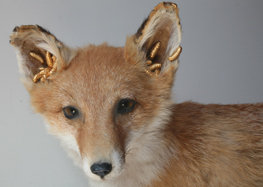Telling tales
dal 13/7/2009 al 17/10/2009
Segnalato da
Tord Boontje
Studio Job
Maarten Baas
Dunne & Raby
Miriam van der Lubbe
Niels van Eijk
Kelly McCallum
13/7/2009
Telling tales
Victoria & Albert Museum, London
Fantasy and fear in contemporary design. The exhibition will focus on work by designers who explore the narrative potential of objects, connecting the past with the present. The exhibition will be structured in three sections: In The Forest Glade, The Enchanted Castle and Heaven and Hell. On show, among the others: Tord Boontje, Studio Job and Maarten Baas.

At a time of heightened interest in works of so-called 'design art', made in small editions for the collector's market, Telling Tales will feature work by a generation of internationally regarded designers. The exhibition will focus on work by designers who explore the narrative potential of objects, connecting the past with the present. The exhibition will be structured in three sections - In The Forest Glade - design that evokes the innocence of fairy-stories will be on display, notably the work of Tord Boontje.
The Enchanted Castle is inspired by the rise of the novel and prints in the 18th century, and features design that parodies and questions decorative taste, exemplified by the work of Studio Job and Maarten Baas. Heaven and Hell is informed by psycho-analysis and the work reflects anxieties about our mortality. Designers in this section will include Dunne & Raby and Miriam van der Lubbe and Niels van Eijk.
The exhibition is in three sections:
The Forest Glade is inspired by fantasy and nature evoking the spirit of fairytales. The Enchanted Castle exaggerates and parodies historical design styles often associated with displays of status. Heaven and Hell is concerned with themes of mortality and the afterlife.
Travel to The Forest Glade
Against all the evidence of an industrialised, globalised, high-tech world (or perhaps because of it) some contemporary designers are retreating to the pastoral setting of fairy tales, myths and nature. In so doing they return us to our most primitive state. No doubt their designs are escapist, even naïve, and can be quite deliberately childlike. Their faux-rustic objects look as though they belong in a forest glade straight from classical mythology or northern European fairy tales, or perhaps even the biblical Garden of Eden. But these designers are deadly serious about wanting to disengage us from ordinary life and reconnect us to a state of innocence and wonder.
The Enchanted Castle
We now enter an Enchanted Castle furnished with marvellous and fantastical objects. Many recall designs from the 18th century, a period that was frequently evoked by later writers and illustrators of fairytales. The 18th century was also the age of the rise of the novel, a new way to tell tales. Early novels, such as Daniel Defoe's Moll Flanders (1722), were descriptions of the material world of Georgian life, as were William Hogarth's print series, such as Marriage à la Mode (1745). In both, style and design were a visual language that indicated social and worldly status. Here we see conventional displays of high status parodied and subverted, through awkward changes of scale or seemingly inappropriate uses of materials.
Travel to Heaven and Hell
At the end of the 19th century, the advent of psychoanalysis opened up the sub-conscious and offered new interpretations of dreams and the imagination. With this came a renewed awareness of mortality and a sense of anxiety about the mutability of life, which Freud described as the 'death drive'. Inspired by this, we here present works that evoke the universal conflict of life and death, heaven and hell, judgement and salvation. Some of these designers refer to the forms of Baroque art, others conjure up memento mori - reminders of our mortality. Still others create agitated designs that explore our anxious state in troubled times.
There is a varied programme of events to complement the exhibition.
This section is provided for journalists to access the latest press releases from the V&A as well as an archive of past releases. Further information can be obtained by contacting our Press Office at press.office@vam.ac.uk.
http://www.vam.ac.uk/microsites/telling-tales/
IMage: ‘Do You Hear What I Hear?’, Kelly McCallum, 2007
Victoria and Albert Museum
Cromwell Road - London SW7
Exhibition opening times Daily 10.00-17.30 Fridays 10.00-21.30 Exhibition closes 15 minutes prior to the Museum closing.
Admission to Telling Tales is free
Late night opening
The V&A is now open late every Friday - why not take this opportunity to visit Telling Tales, meet friends and have a drink in our café-bar.



